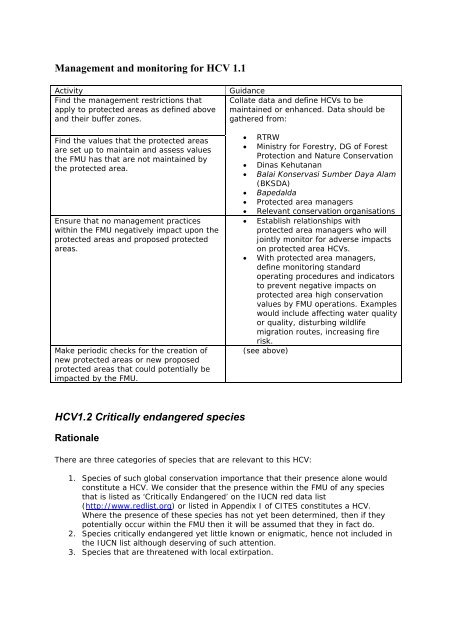English - HCV Resource Network
English - HCV Resource Network
English - HCV Resource Network
You also want an ePaper? Increase the reach of your titles
YUMPU automatically turns print PDFs into web optimized ePapers that Google loves.
Management and monitoring for <strong>HCV</strong> 1.1<br />
Activity<br />
Find the management restrictions that<br />
apply to protected areas as defined above<br />
and their buffer zones.<br />
Find the values that the protected areas<br />
are set up to maintain and assess values<br />
the FMU has that are not maintained by<br />
the protected area.<br />
Ensure that no management practices<br />
within the FMU negatively impact upon the<br />
protected areas and proposed protected<br />
areas.<br />
Make periodic checks for the creation of<br />
new protected areas or new proposed<br />
protected areas that could potentially be<br />
impacted by the FMU.<br />
Guidance<br />
Collate data and define <strong>HCV</strong>s to be<br />
maintained or enhanced. Data should be<br />
gathered from:<br />
• RTRW<br />
• Ministry for Forestry, DG of Forest<br />
Protection and Nature Conservation<br />
• Dinas Kehutanan<br />
• Balai Konservasi Sumber Daya Alam<br />
(BKSDA)<br />
• Bapedalda<br />
• Protected area managers<br />
• Relevant conservation organisations<br />
• Establish relationships with<br />
protected area managers who will<br />
jointly monitor for adverse impacts<br />
on protected area <strong>HCV</strong>s.<br />
• With protected area managers,<br />
define monitoring standard<br />
operating procedures and indicators<br />
to prevent negative impacts on<br />
protected area high conservation<br />
values by FMU operations. Examples<br />
would include affecting water quality<br />
or quality, disturbing wildlife<br />
migration routes, increasing fire<br />
risk.<br />
(see above)<br />
<strong>HCV</strong>1.2 Critically endangered species<br />
Rationale<br />
There are three categories of species that are relevant to this <strong>HCV</strong>:<br />
1. Species of such global conservation importance that their presence alone would<br />
constitute a <strong>HCV</strong>. We consider that the presence within the FMU of any species<br />
that is listed as ‘Critically Endangered’ on the IUCN red data list<br />
(http://www.redlist.org) or listed in Appendix I of CITES constitutes a <strong>HCV</strong>.<br />
Where the presence of these species has not yet been determined, then if they<br />
potentially occur within the FMU then it will be assumed that they in fact do.<br />
2. Species critically endangered yet little known or enigmatic, hence not included in<br />
the IUCN list although deserving of such attention.<br />
3. Species that are threatened with local extirpation.

















